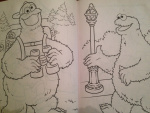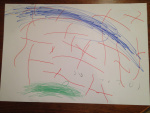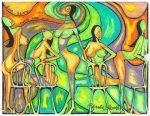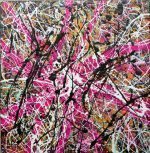Creative Expression to Collectively Open Minds
My soon-to-be four year old granddaughter refuses to try to color in the lines. She hates coloring books, but loves to draw and paint freehand. These are birds flying in the air.


Her daddy is an artist and these are a few of his works:



Misha Burnett did a post today that got me thinking about art, music and writing….mostly creativity, whether traditionally or independently produced.
Take art.
Jackson Pollock, Picasso and Rembrandt. All three different styles. All three with their own audience…all styles that were copied.



There are those who swear only their preferred style of art is worthy. Yet there are those art critics who can appreciate the variety of all three. It is the unique expression of creativity from the soul that makes them worthy.
Take music.
Again, tastes vary tremendously. The people who enjoyed this:
Often Detested This:
And many who loved this:
Can’t stand this:
Yet they all have had an audience. Many can appreciate all forms of music.
It’s all good. Influential artistry.
It demonstrates our collective creativity.
Now, more than ever, writers have an opportunity to express their creativity.
Dare to be Different!
Writing is like art and music. Along with specific genre choices, people develop an expectation of what is acceptable to them regarding writing style, content, voice, person, POV, execution techniques, formatting choices. When we deviate from that which is expected, we break out of a traditional mold and become creative. Breaking from tradition always carries risks. But, is creativity a bad thing or a good thing? I personally believe creativity is an awesome thing, a powerfully liberating thing…provided the artist, in this case the writer, can attract the right audience. Find your audience.
There are always going to be critics who don’t like your work. It is written in the “wrong” person, the prose is too flowery, the characters didn’t develop “properly”, and the ending was not satisfying. I have been reading reviews of great classics and people are making the same complaints about them as they are contemporary works, because everyone is a master in their own mind.
Industry standards are often creativity killers.
Be your own master.
Don’t be an industrial slave unless you choose to be.
Write what you are passionate about. Write how you feel it. Write in the way that is comfortable to you. Write what comes naturally. Don’t force your writing into a mold.
Sure, edit properly. Follow the rules that govern language and grammar, but don’t be afraid to deviate. Don’t be afraid to be creative. Sing your own song. Color outside the lines if it pleases you.
Can you think of books that opened your mind that were written differently than the traditional novel?
“The Color Purple” by Alice Walker, Pulitzer Prize winner, comes to mind.
Ursula K. Le Guin challenged the world with her mix of fantasy and sci-fi at a time when to deviate was simply unacceptable.
“The Book Theif” by Markus-Zusak, published by Random House, is an historical fiction that was narrated by Death, and is a book for teens and adults, with nearly 8000 positive reviews.
Filed under: Writing Process/WIPs Tagged: art, collective, creativity, independent, industry standards., Master, music, slave, traditional, writing











